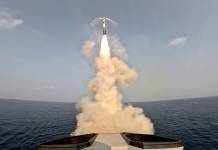Some of the Indian Navy’s advanced light helicopters (ALH) Mk-III will be equipped with an indigenous low-frequency dunking sonar, capable of conducting anti-submarine warfare, reports suggest.
The ALH Mk-III choppers that were handed over to the Navy and the Coast Guard last month are the latest variant of the highly successful ALH Dhruv helicopter outfitted with modern sensors.
The list of features the helicopter’s maker HAL (Hindustan Aeronautics Limited) is offering in the ALH Mk-III is exhaustive.
With the local development and production, the integration of sensors and equipment has become easier for the Indian defense industry – including the IFF MKXII & ATC Xpdr with ADS-B Out, V/UHF communication system, traffic alert and collision avoidance (TCAS-I), SAR Homer system and automatic deployable emergency locator transmitter (ADELT).
A Loud hailer, radio altimeter, rescue basket, medical intensive care unit (MICU), IADS system, AFCS, digital video recording system (SSDVR), automatic identification system (AIS), high-intensity searchlight (HISL), pressure refueling system, control grip, EO POD Rev III, surveillance radar system and 12.7 mm gun system, and a lot more are also being provided for the Indian Navy, making this platform a truly versatile utility helicopter.
And according to reports, 6 out of 16 helicopters ordered by the service are also getting more teeth with the addition of a Low-Frequency Dunking Sonar (LFDS), aiding in anti-submarine warfare abilities.
Six of the 16 naval Mk-III ALH are to be equipped with an indigenous low frequency dunking sonar (LFDS) developed by Kochi-based Naval Physical and Oceanographic Laboratory….@realkaypiushttps://t.co/jBzaTUSwWv https://t.co/zHapcea5Wr
— All Things Indian Navy (@ThingsNavy) May 10, 2021
This LFDS is developed by the Kochi-based Naval Physical & Oceanographic Laboratory (NPOL), and can be deployed by rotary-wing platforms especially the ALH Mk-III, acting as a force multiplier for surface vessels. It provides the advantages of lower frequency combined with higher source level for range advantage in littoral ASW.
It enables the deployment of sensors to deeper depths for the detection of submarines. LFDS is an integrated system using indigenous technology capable of simultaneously processing inputs from sonobuoys and operating the dunking sonar for establishing exact range and bearing values with active low-frequency transmission, according to NavyRecognition.
Interestingly, in other photos, the helicopter is also seen armed with torpedoes, however, not much information available is available on the prototype.
It is still unclear if the Naval Dhruv Mk III can carry munitions or not, but is certainly an idea too lucrative for the Indian industry to ignore and if the photos are true, testings are already underway.
The Indian Navy has been looking for a new utility helicopter to replace its Sea King fleet, for which the service placed an order for 24 MH-60R helicopters from the United States built by Lockheed Martin.
According to an Indian news website LiveMint, this acquisition of two dozen MH-60R maritime utility helicopters come under a $2.6 billion deal inked in February last year. The first three out of 24 MH-60R Seahawks are expected to be delivered between June and September 2021.
The MH-60R, along with the Naval ALH Mk-III will probably form the Indian Navy’s primary utility helicopter fleet, if things go smooth for the state-owned Hindustan Aeronautics Limited.
The Indian helicopter had faced several roadblocks in its acceptance, especially due to issues like complications in the blade folding mechanism. The Indian Navy also operates Russian Made Kamov Ka-28 and Ka-31 helicopters for anti-submarine warfare.





